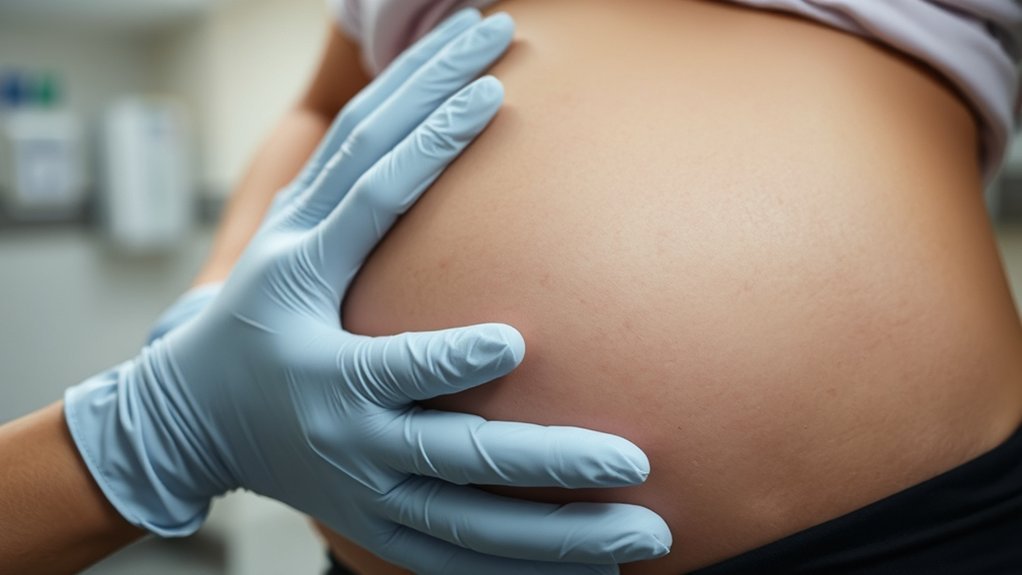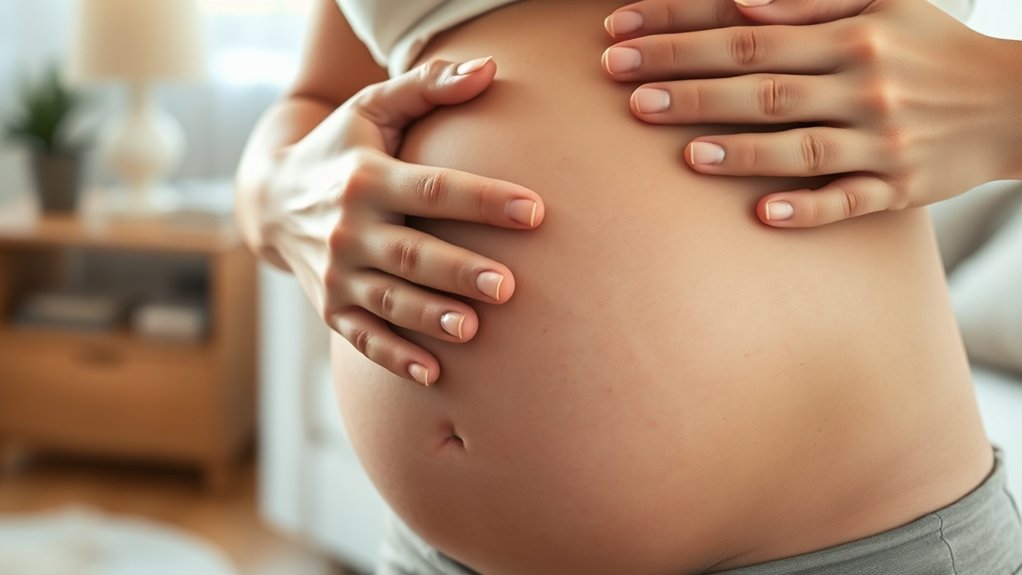After experiencing a perineal tear during delivery, you might find yourself wondering about the best ways to care for your stitches. Proper management is essential for your recovery, as neglecting this can lead to complications. Understanding the nuances of pain management, hygiene, and nutrition can greatly impact your healing process. What specific strategies can you implement to guarantee a smoother recovery and enhance your overall well-being during this critical period?
Understanding Stitches and Their Importance in Pregnancy
When you give birth, understanding stitches and their role in your recovery is vital. Stitches are often necessary to repair perineal tears or episiotomies, especially for second-degree tears and beyond. They promote healing and help restore the affected area.
Most commonly, dissolvable stitches are used, beginning to dissolve within ten days and typically disappearing completely within six weeks. This process minimizes invasive healing.
It’s important to care for these stitches post-delivery to prevent infection, which may present as swelling or increased pain. For pain relief, acetaminophen can help manage discomfort.
Additionally, monitoring bowel movements is important; a balanced diet and stool softeners can prevent straining that might jeopardize your stitches and hinder recovery. Furthermore, understanding the signs and symptoms of preeclampsia is crucial for overall maternal health during pregnancy.
Pain Management After Episiotomy or Perineal Tear
After an episiotomy or perineal tear, managing pain is vital for your comfort and recovery.
You’ll find that options like acetaminophen and ice packs can provide relief, while maintaining good hygiene is essential to prevent infection. Understanding your healing time expectations will also help you navigate this recovery period more effectively. Additionally, consulting resources like Bumps can offer valuable insights into medication safety during pregnancy.
Pain Relief Options
Managing pain after an episiotomy or perineal tear is essential for your comfort and recovery. For effective pain relief, regular-strength acetaminophen (Tylenol) is generally recommended, while aspirin and ibuprofen should be avoided unless your healthcare provider advises otherwise.
In the first 24 hours post-delivery, applying ice packs to the perineal area for 10-20 minutes can help reduce swelling and alleviate discomfort. You might also consider using anesthetic pads or ointments for temporary numbing relief.
Additionally, gentle pelvic floor exercises can promote healing and ease discomfort, so introduce them gradually and with guidance from your healthcare provider.
Hygiene Practices Importance
Maintaining proper hygiene is essential for your recovery after an episiotomy or perineal tear, as it considerably reduces the risk of infection.
Rinse the area with warm water after using the toilet, and consider using a squeeze bottle for gentle cleansing. Always wash your hands thoroughly before and after changing pads to minimize bacteria introduction.
Your healthcare provider may give you specific instructions, including using mild, unscented soap to avoid irritation.
Keeping the perineal area dry is vital; gently pat the area dry with a clean towel instead of rubbing.
Wearing breathable, loose-fitting underwear helps reduce moisture buildup and friction on the healing stitches, allowing your body to heal within a safe and comfortable environment.
Healing Time Expectations
While each woman’s experience varies, you can generally expect healing from an episiotomy or perineal tear to occur within a month. Most women notice a gradual reduction in pain during this healing process. Dissolvable stitches will start to dissolve after ten days, fully disappearing by six weeks postpartum.
| Healing Timeline | Notes |
|---|---|
| First Week | Initial pain; use pain relief |
| Two Weeks | Stitches dissolve; monitor pain |
| Four Weeks | Significant pain reduction |
| Six Weeks | Full recovery; consult healthcare provider for concerns |
Regular pain relief, like paracetamol, is safe for breastfeeding mothers. If you notice increased pain, swelling, or unusual discharge, contact your healthcare provider immediately for proper care. Complete comfort might take up to six months, so pelvic floor exercises can aid recovery.
Hygiene Practices for Optimal Recovery
Maintaining proper hygiene is essential for your recovery after delivery.
You should establish a daily cleansing routine and guarantee your wound care is meticulous to prevent infection and promote healing.
Daily Cleansing Routine
To guarantee ideal recovery after childbirth, it’s crucial to establish a daily cleansing routine for the perineal area. Proper hygiene practices can help prevent infection and promote healing.
Here are some steps to follow:
- Use a squeeze bottle filled with warm water to rinse the area after using the toilet.
- Avoid using soap directly on the stitches; instead, clean the area gently with water.
- Pat the area dry with a clean towel or allow it to air dry to keep stitches clean and dry.
- Regularly change sanitary pads to maintain hygiene.
- Always wash your hands before and after handling the perineal area.
Following these daily cleansing routines will greatly aid in your recovery process.
Proper Wound Care
After establishing a daily cleansing routine, proper wound care becomes the next essential step in your recovery journey.
Keep the stitched area clean and dry by gently washing it with warm water daily, avoiding harsh soaps that may irritate the wound. Your healthcare provider will likely recommend using a squeeze bottle to rinse the perineal area after using the toilet, which helps reduce irritation.
Change sanitary pads regularly to prevent moisture accumulation, minimizing the risk of infection. Always wash your hands before and after touching the stitched area or changing pads.
Monitor for any signs of infection, such as increased redness, swelling, or discharge. If you experience any of these symptoms or persistent pain, consult your healthcare provider promptly.
Coping With Discomfort: Home Remedies
Here are some strategies to help ease discomfort in the perineal area:
- Apply an ice pack for 10-20 minutes to reduce swelling and pain.
- Take warm sitz baths to soothe soreness and support the healing process.
- Use a squeeze bottle filled with warm water for gentle cleansing after using the toilet.
- Keep the perineal area clean and dry to prevent infection.
- Consider over-the-counter pain relief, like regular-strength acetaminophen, to manage minor aches.
Additionally, it’s crucial to follow up with your healthcare provider for prenatal care to ensure proper healing and address any concerns during recovery.
Dietary Considerations to Prevent Constipation

Maintaining a healthy diet during pregnancy is essential, especially when it comes to preventing constipation. A balanced diet rich in dietary fiber—think fruits, vegetables, whole grains, and legumes—can help promote regular bowel movements. Aim for at least 25 to 30 grams of fiber daily to support your digestive health and reduce straining.
Staying well-hydrated by drinking about 8-10 cups of water each day is vital, as it softens stool and aids digestion. Incorporate foods like prunes, pears, and oats, known for their natural laxative effects. Additionally, malnutrition poses significant threats to health, making it crucial for pregnant individuals to prioritize nutrition during this important time.
Furthermore, regular physical activity, such as walking or prenatal yoga, can stimulate intestinal function, further minimizing the likelihood of constipation during this important time.
Recognizing Signs of Infection
Recognizing the signs of infection at the stitch site is vital for your recovery during pregnancy.
Being aware of these symptoms can help you seek timely medical advice:
- Increased redness, swelling, and warmth at the stitch site
- Persistent pain or tenderness that doesn’t improve
- Unusual discharge with a foul odor
- Fever over 100.4 degrees Fahrenheit, especially with other symptoms
- Separation of stitches or excessive bleeding
If you notice any of these signs, it’s important to contact your healthcare provider promptly.
Early intervention can prevent complications and guarantee your health and that of your baby. Additionally, it is advisable to consult with a specialist in Maternal-Fetal Medicine for comprehensive care during high-risk situations.
Stay vigilant and prioritize your well-being during this important time.
Pelvic Floor Exercises for Healing
Pelvic floor exercises, often referred to as Kegel exercises, play an essential role in your recovery after childbirth by strengthening the muscles around your vagina and anus.
These exercises promote healing and can be performed anywhere, anytime, making them a convenient option for postpartum recovery. It’s recommended to start as soon as you feel comfortable after delivery.
Regular practice—aiming for three sets of 10-15 repetitions each day—can help prevent issues like incontinence and pelvic organ prolapse caused by weakened pelvic muscles. Additionally, consulting a midwife or healthcare provider for guidance on proper techniques can enhance the effectiveness of these pelvic floor exercises, ensuring you maximize their benefits and support your recovery journey.
Tips for Managing C-section Incisions

Managing your C-section incision is essential for a smooth recovery.
You’ll want to keep the area clean and dry, washing it gently with warm water daily to reduce the risk of infection.
It’s also important to recognize signs of infection, such as fever or unusual redness, so you can seek help promptly. Additionally, be aware of hormonal fluctuations that may affect your healing process and emotional well-being during this time.
Incision Cleaning Techniques
Proper care of your C-section incision is critical for promoting healing and preventing infection. Here are some effective incision cleaning techniques to follow:
- Clean the incision daily with warm water and mild soap, gently patting it dry with a clean towel.
- Avoid hydrogen peroxide or alcohol, as they can irritate the skin and delay the healing process.
- Keep the incision covered with a breathable dressing for the first few days, changing it regularly.
- Monitor for any infection signs, such as increased redness, swelling, or discharge, and consult your healthcare provider if these occur.
- Follow your healthcare provider’s instructions regarding activity restrictions and when to discontinue dressings to guarantee proper healing.
Recognizing Infection Signs
How can you tell if your C-section incision is becoming infected? Recognizing infection signs is vital for your recovery. Watch for these symptoms:
| Symptoms | Action |
|---|---|
| Fever over 100.4°F | Contact your healthcare provider. |
| Persistent drainage | Seek medical attention immediately. |
| Redness or swelling | Monitor closely and reach out if worsening. |
It’s essential to keep the incision clean and dry. If you notice unusual changes, like pus or a foul smell, act quickly; these may indicate an infection. Regularly check for increased pain or wound edge separation. Following your healthcare provider’s care instructions and attending all follow-up appointments can greatly reduce your risk of complications. Your well-being matters.
Support Systems for Postpartum Recovery

Establishing a strong support system during the postpartum period is essential for your emotional and physical recovery. Engaging family, friends, and healthcare providers can greatly enhance your well-being.
A robust support system is vital for postpartum recovery, enhancing both emotional and physical well-being.
Consider these key elements for effective support:
- Open communication about mental health and recovery needs
- Regular check-ups with your healthcare provider to address any concerns
- Help with household tasks, childcare, and meal preparation
- Connecting with local support groups or online communities for shared experiences
- Emotional support from loved ones to navigate challenges
Additionally, utilizing resources like the PSI app can provide immediate access to valuable information and support.
When to Seek Medical Attention
Recognizing when to seek medical attention after childbirth is essential for ensuring your recovery goes smoothly.
If you develop a fever over 100.4 degrees Fahrenheit, this could indicate an infection related to your stitches. Persistent drainage, increased tenderness, or unusual redness and swelling around your stitches are also signs that warrant a consultation with your healthcare provider.
If you notice any separation of the stitches or experience severe pain that doesn’t improve with standard pain relief, contact your provider immediately.
Additionally, changes in the appearance of your stitches, such as pus or a foul odor, require prompt medical evaluation.
Finally, difficulty urinating or significant pain during bowel movements may suggest complications needing urgent attention. It is important to reach out for support, especially if you are a parent of a premature or sick baby, as organizations like Bliss offer support for parents and families navigating such challenges.
Frequently Asked Questions
How to Cure Stitches During Pregnancy?
To care for stitches during pregnancy, keep them clean and dry, apply ice packs for swelling, take pain relief as advised, and monitor for infection signs. Consult your healthcare provider for any concerns.
Is It Normal to Have Pain in Stitches During Pregnancy?
Yes, it’s normal to experience pain in stitches during pregnancy. Hormonal changes affect healing, and increased pelvic pressure can exacerbate discomfort. Keep the area clean, monitor for signs of infection, and consult your healthcare provider if needed.
How to Relieve Pain From Stitches After Birth?
To relieve pain from stitches after birth, apply ice packs for swelling, take acetaminophen for discomfort, practice warm sitz baths for soothing relief, and maintain hygiene to promote healing and prevent infection.
What Pain Relief Tablets Are Available for Pregnancy Stitches?
For pain relief from stitches during pregnancy, regular-strength acetaminophen is generally safe. Always consult your healthcare provider before taking any medication, especially if you have specific health concerns or ongoing pain at the stitch site.
Conclusion
In your journey to recovery after stitches from an episiotomy or perineal tear, remember that taking care of yourself is paramount. By following proper hygiene, managing pain, and incorporating gentle exercises, you’ll be on the road to healing. Don’t hesitate to reach out for support; it truly takes a village. If you notice any unusual symptoms, seek medical attention promptly. Prioritize your well-being, and you’ll find that brighter days are just around the corner.
